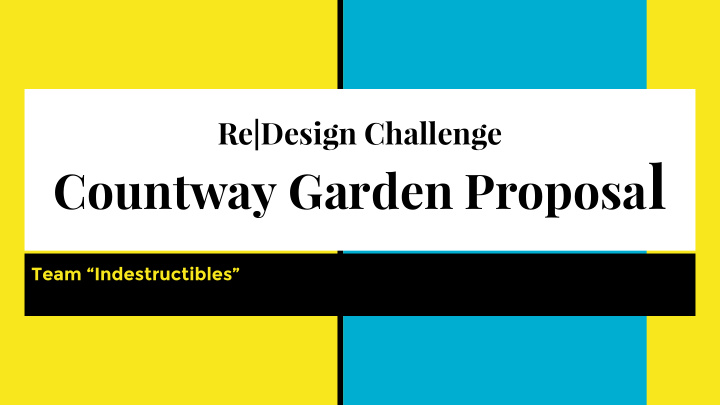



Re|Design Challenge Countway Garden Proposa l Team “Indestructibles”
Our Vision & Mission • To enhance the health and well-being of the Longwood community by providing an attractive green space for peaceful contemplation, discussion and learning • To provide a living example of sustainable urban development for Harvard and the surrounding communities
Plan View of the Re(Design)
3-D Perspective of the Re(Design)
Key Design Elements Boardwalk | comfortable, aesthetic, meditative walking path for visitors;space for contemplation and discussions . Green Wall | to limit the influx of noise from the generator and road traffic. Greenhouse | to enable growth of plants under severe winter and snow; to protect produce from pests. Organic | to include fresh organic produce in Longwood cafeterias enhancing community health. On-site Composting | manage organic waste sustainably reducing waste as well as need of procuring fertilizer . Waterproofing | protect library assets beneath the garden and quick drainage of stormwater. Rainwater Harvesting | conservation of water; to provide an on-site resource for watering plants Solar Lighting | to light up the garden during night without adding additional load to the grid. Relocation of Bike Racks | to promote the interaction and involvement of bike commuters with the garden . Community Involvement | to bring together the Harvard Longwood community with a common vision of healthy living, sustainability, environmental management, collaboration and exchange of new ideas/learning opportunities Sustainable Material Use/Reuse | to minimize the carbon footprint throughout the lifecycle of garden; reduce waste.
Dealing with the Noise GENERATOR Green Wall | To reflect and absorb the noise produced by the generator
Dealing with Heat Boardwalk | Reducing the exposure of the brick paving to the sun by creating a recycled wood boardwalk and adding plants will make the garden more comfortable, as these materials prevent the brick from re-radiating the heat. Vegetation is known to reduce the air temperature by as much as 5°C.
Dealing with Pests Chicken Wire Mesh Cages & Greenhouse | To protect plants from pests. Greenhouse can be used for sturdier defense against both pests and cold weather.
Material Selection Boardwalk ● - Trex (made of 95% recycled wood) Green Wall ● - Stainless steel frame Greenhouse ● - Reclaimed wood and plexiglass, or recycled windows Waterproofing ● - EPDM Rubber Rainwater Barrel ● - Recycled food-grade plastic
Estimated Costs • Boardwalk - approx. $8 per square foot ≈ ($8/ft 2 ) * (12 ft x 90 ft) = $8640 (link to reference) • Green Wall - approx. $100 per square foot ≈ ($100/ft 2 ) * (11 ft x 90 ft) = $99,000 (link to reference) • Greenhouse - approx. $100 (link to reference) • Waterproofing - approx. $6 per square foot ≈ ($6/ft 2 ) * (12 ft x 90 ft) = $6480 (link to reference) • Rainwater Barrel - approx. $80 (link to reference) • Solar-powered Lighting - approx. $300 (link to reference) • Total estimated cost = “ $114,600”
Site Analysis Visual observation in order to determine the Using a Solar Path Finder tool to determine what opportunities and the limitations of the site times of the year the garden receives direct sun.
Site Analysis - Radiation Map Summer Solar Radiation Map Winter Solar Radiation Map (assuming no foliage for trees) The above solar radiation maps indicate the areas of garden that receive adequate sun for growing plants. This solar exposure was taken into account when planning the garden.
Estimating Yield of Vegetables Plants have specific RUE (Radiation Use Efficiency) which can be used to determine its yield based on solar radiation absorbed, assuming ideal soil and water conditions. For tomatoes, it is 20g/MJ i.e. 1 MJ of solar energy yields 20g of tomatoes. 1kWh = 3.6MJ Summer Solar Radiation Map Estimating Tomato Yield in Countway Garden: Taking 300kWh/m2 Solar Radiation for summer months, 1 sq. meter plot produces (300kWh/m2 X 3.6 X 20g/MJ)= 21.6 kg of tomatoes
Recommend
More recommend